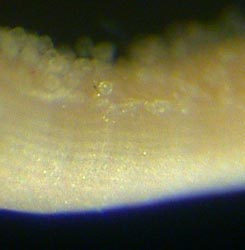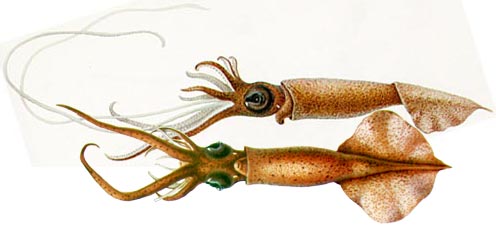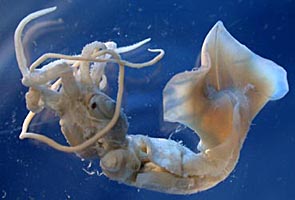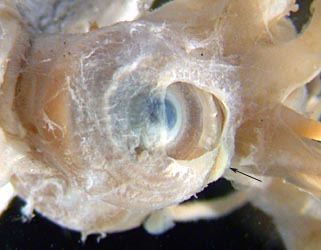Mastigoteuthis glaukopis
Richard E. Young and Michael VecchioneIntroduction
The type description of M. glaukopis is based on a single, small squid (37 mm ML) with one intact tentacle, taken off the tropical, east African coast.
Brief diagnosis:
A member of the M. glaukopis Group with ...
- an Indian Ocean distribution.
Characteristics
- Arms
- Arm suckers with blunt, conical teeth around opening, with 5-7 slightly larger teeth distally.
- Tentacles
- Tentacle whiplike; club not wider than stalk.
- Club 70% of tentacle length.
- Club with indistinct undulating protective membrane.
- Proximally club with very small, scatteren suckers; club then widens to occupy half the tentacle surface. Distally club extends to leave only about one third of circumference bare with suckers situated close together, nearly touching one another.
- Club suckers become slightly larger distally except near tip.
- Club suckers 0.1 mm in diameter.
- Club suckers with 10-12 small teeth at approximately regular intervals around inner ring. These teeth are difficult to distinguish from conical knobs on the outer rings.
- Head
- Eyes large (15% of ML); occupy most of head.
- Olfactory organ with short stalk; located on obliquely directed gelatinous pad of neck.
- Funnel pocket appears to be present (holotype). Funnel adductors show whitish through shallow funnel groove.
- Funnel locking-apparatus
- Funnel locking apparatus with tragus but no antitragus; however, "cartilaginous groove is slightly inflated at the position of the antitragus, so that it gives the indication of an antitragus."
- Mantle
- Tubercules absent from mantle and elsewhere.
- Fins
- Fin length about half of ML; shape nearly rhomboidal.
- Photophores
- Integumental photophores absent.
- Eyelid photophore present; 1 mm wide
- Pigmentation
- Vivid reddish-brown color.
- Sparse chromatophores on tentacles and oral surfaces of arms.
- Measurements Measurements according to Chun (1910) are: Mantle length - 37 mm; mantle width - 8 mm; eye diameter - 5.5 mm ML; tentacle length - 84 mm; club length - 58 mm.



Figure. Tentacular club of M. glaukopis, holotype. Top - View of the twisted club and an aboral view of an enlargement of a portion of the club. Drawings from Chun (1910). Bottom - Slde view of portion of the club. The protective membrane can be detected but little remains of it. Photograph by R. Young
Figure. Ventral view of funnel locking-apparatus of M. glaukopis, holotype. Drawing from Chun (1910).
Figure. Side view of the head of M. glaukopis showing the eyelid photophore (arrow), holotype. Photograph by R. Young.
Comments
Although we have examined the holotype, most of the above description, with the exception of the photographs, is from Chun (1910) since many features are no longer apparent on the holotype. This young mastigoteuthid is similar to M. atlantica and M. famelica in lacking integumental photophores but having a large photophore on each eyelid. It differs from both species in the structure of the club suckers (i. e., small size; absence of large lateral pegs on outer ring). Since these latter features change with size, we can find no differences that separate M. glaukopis Chun, 1908 and it is probably synonymus with M. atlantica Joubin, 1933 or M. famelica Berry, 1909, but has priority over both. Until larger specimens of M. glaukopis are available from the Indian Ocean, we maintain all three species. We suspect, however, on the basis of the distinct protective membrane on the tentacular club in the illustrations of Chun (1910) (see above) that M. glaukopis and M. atlantica may be synonymous.
References
Chun, C. 1910. Die Cephalopoden. Oegopsida. Wissenschaftliche Ergebnisse der Deutschen Tiefsee Expedition auf dem Dampfer "Valdivia" 1898-1899, 18(1):1-401.
Title Illustrations

| Scientific Name | Mastigoteuthis glaukopis |
|---|---|
| Comments | Side (top) and ventral views. |
| Reference | Chun, C. 1910. Die Cephalopoden. Oegopsida. Wissenschaftliche Ergebnisse der Deutschen Tiefsee Expedition auf dem Dampfer "Valdivia" 1898-1899, 18(1):1-401. |
| View | Dorsal and ventral |
| Size | 37 mm ML |
| Type | Holotype |
| Scientific Name | Mastigoteuthis glaukopis |
|---|---|
| Specimen Condition | Dead Specimen |
| View | Ventral |
| Size | 37 mm ML |
| Type | Holotype |
| Copyright |
© Richard E. Young

|
About This Page
Richard E. Young

University of Hawaii, Honolulu, HI, USA

National Museum of Natural History, Washington, D. C. , USA
Page copyright © 2005 Richard E. Young and
All Rights Reserved.
- First online 09 September 2005
- Content changed 19 November 2007
Citing this page:
Young, Richard E. and Vecchione, Michael. 2007. Mastigoteuthis glaukopis . Version 19 November 2007 (under construction). http://tolweb.org/Mastigoteuthis_glaukopis/52637/2007.11.19 in The Tree of Life Web Project, http://tolweb.org/












 Go to quick links
Go to quick search
Go to navigation for this section of the ToL site
Go to detailed links for the ToL site
Go to quick links
Go to quick search
Go to navigation for this section of the ToL site
Go to detailed links for the ToL site